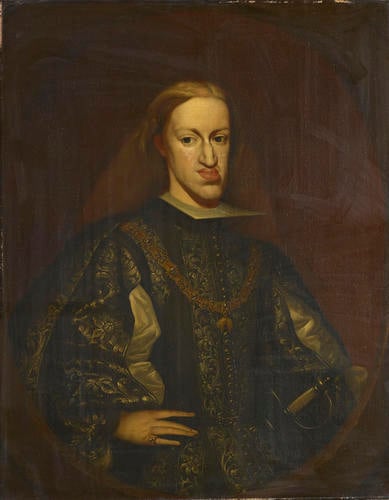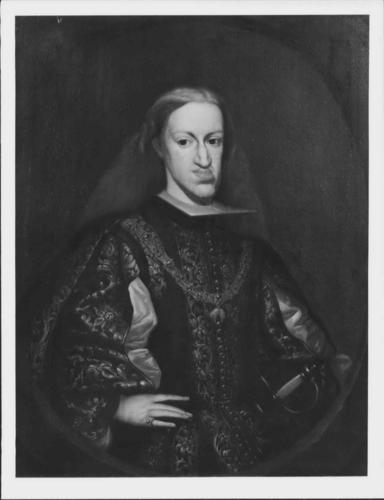Carlos II, King of Spain (1661-1700) c.1680-85
Oil on canvas | 93.4 x 73.0 cm (support, canvas/panel/stretcher external) | RCIN 403018
-
Carlos II was the last of the Habsburg dynasty to rule Spain. Known as 'the Bewitched' he suffered from physical and intellectual disabilities cause by generations of inbreeding and was regarded as a weak and ineffectual ruler. At his death he left the Spanish throne to his grand-nephew, Philip of Anjou, causing fears over a Franco-Spanish alliance which ultimately led to the War of Spanish Succession.
This portrait of Carlos II of Spain dates from around 1680, when the king was nineteen, it appears to be based on the painting by Claudio Coello (1642-1693), now in the Museu Nacional d'Art de Catalunya, Barcelona (inv. no. 024227-000). Alongside the court painters Francisco Rizi, Juan Carreño de Miranda and Francisco de Herrera II, Claudio Coello was one of the leading exponents of the late Spanish Baroque style that developed between c.1660 and 1700. Distinct from that of the previous generation of Spanish Baroque artists, these painters absorbed the influence of the Venetian Renaissance, as well as contemporary Italian and Flemish art, examples of which were plentiful in Madrid in royal and aristocratic collections, to create a style characterised by theatrical compositions and rich colours. Although Coello is best remembered as a painter of religious scenes in oil and fresco, he also produced a small number of secular scenes, principally portraits, of which those of Carlos II and his mother, Marianna of Austria (Alte Pinakothek, Munich) are the most successful.It is unlikely that this painting can be attributed to Coello himself; although the details of the costume, the sword hilt and the Order of the Golden Fleece are competently painted, the golilla – the starched white collar popular in Spain in the later seventeenth century, is awkwardly positioned. Additionally, the treatment of the king's characteristic Hapsburg chin, overhanging lower lip and long, bulbous nose is less flattering than was customary in portraits by artists of Coello's talent. It is likely that the portrait in the Royal Collection was painted by a relatively undistinguished member of Coello's circle or following.
A large number of portraits of this type exist in both full and half-length formats, depicting the Spanish king at varying ages. The finest examples are attributed to Juan Carreño de Miranda, who held the post of Pintor de Cámara at the court of Carlos II between 1671 and his death in 1685. Carreño's half-length portrait of Carlos II, dated 1680 (Museum del Prado, Madrid) is similar in overall composition to Coello's painting and may be considered the first of this portrait type. A drawing of Carlos II directly related Carreño's autograph painting survives in the Royal Academy of Fine Arts of San Fernando.
Provenance
First recorded in the reign of Queen Victoria at Buckingham Palace, 1876; previously hanging at Cumberland Lodge.
-
Creator(s)
-
Medium and techniques
Oil on canvas
Measurements
93.4 x 73.0 cm (support, canvas/panel/stretcher external)
110.5 x 90.4 x 8.0 cm (frame, external)
Category
Object type(s)
Alternative title(s)
Philip III(?), King of Spain
Charles VI(?)









